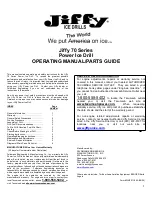
Work area
1. Keep work area clean and well lit. Cluttered and dark areas invite accidents.
2. Do not operate power tools in explosive atmospheres, such as in the presence of flammable liquids,
gases or dust. Power tools create sparks which may ignite the dust or fumes.
3. Keep children and bystanders away while operating a power tool. Distractions can cause you to lose
control
Electrical Safety
1) Do not abuse the cord. Never use the cord to carry the tool. Keep cord away from heat, oil, sharp
edges, or moving parts. Replace damaged cords immediately. Damaged cords may create a fire.
(The following applies only to tools with a separate battery pack)
2) A battery operated tool with integral batteries or a separate battery pack must be recharged
only with the specified charger for the battery. A charger that may be suitable for one type of
battery may create a risk of fire when used with another battery.
Personal Safety
1. Stay alert, watch what you are doing and use common sense when operating a power tool. Do not
use a power tool while you are tired or under the influence of drugs, alcohol or medication. A moment
of inattention while operating power tools may result in serious personal injury.
2. Dress properly. Do not wear loose clothing or jewelry. Contain long hair. Keep your hair, clothing, and
gloves away from moving parts. Loose clothes, jewelry, or long hair can be caught in moving parts.
3. Avoid accidental starting. Be sure switch is in the locked or off position before inserting batter pack.
Carrying tools with your finger on the switch invites accidents.
4. Do not overreach. Keep proper footing and balance at all times. Proper footing and balance enable
better control of the tool in unexpected situations
5. Use safety equipment. Always wear eye protection, Dust mask, non-skid safety shoes, hard hat, or
hearing protection must be used for appropriate conditions.
Power tool use and care
1. Use clamps or other practical ways to secure and support the work piece to a stable platform.
Holding the work piece by hand or against your body is unstable and may lead to loss of control.
2. Do not force tool. Use the correct tool for your application. The correct tool will do the job better and
safer at the rate for which it is designed.
3. Do not use tool if switch does not turn it on of off. A tool that cannot be controlled with the switch is
dangerous and must be repaired.
4. Store idle tools out of reach of children and other untrained persons. Tools are dangerous in the
hands of untrained users













































